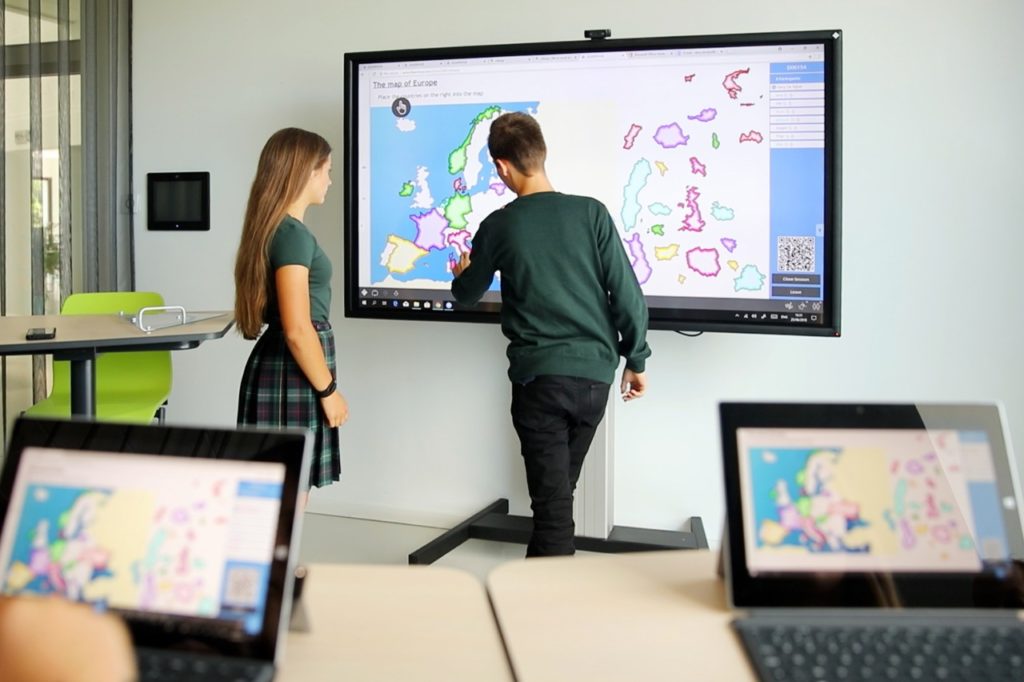
-







-






Latest posts

27 de October de 2021
Share:

Florencia
AV & Collaboration Specialist
Study online without giving up face-to-face classes: that's what hybrid classrooms are all about. In this article, we will discuss what it entails, how it is delivered, and why it is the future of education. In recent months, the following concepts have gained significant attention: telework, AI, video calls, and hybrid classrooms, becoming trending topics. This teaching modality, which combines the best of online education with the most valuable aspects of face-to-face learning, has been establishing itself as the most suitable format for educating in the digital age for several years. Due to the current pandemic situation, it has gained even more prominence, sparking debates on how education should be in a world with dynamic restrictions. Online education offers several advantages: flexibility, work-life balance, cost savings, greater autonomy, direct access to prestigious professors, etc. However, face-to-face education also has many strengths: close interaction with the teacher, an environment that facilitates learning, and social relationships that emerge in the classroom. So, if you combine the best of both, the result is promising. In Europe, they began the digital transformation several years ago and call it blended learning. It resembles what we have seen in recent months, with schools and universities transitioning traditional teaching to the virtual environment. In summary, hybrid education involves a specific itinerary design that leverages the advantages of both online and face-to-face approaches. Hybrid education offers a wide variety of models and approaches that seek to combine the best of face-to-face and online teaching. These methods allow for adapting instruction to the individual needs of students and taking advantage of the benefits of both modalities. Once you discover what hybrid teaching is all about, you won't want to go back to traditional methods. Below, we explore some of the most common hybrid education models, each with its unique characteristics and benefits. This involves dividing students into teams that rotate through different stations with various tasks but with the same objective. At least one of these stations is digital. This model is primarily designed for early education stages (Preschool, Elementary). Similar to the previous one, but one of the stations is a technology lab or computer lab. Rotation is not done in groups but individually, as determined by the teacher or an algorithm. The uniqueness of this hybrid education model is that it is not necessary to work at all stations. Students review the content online first and then attend class. The advantage is clear: the teacher can focus the session on resolving doubts, posing questions, or delving into more complex topics. This model gives the most autonomy to the student, as they decide how much time to dedicate to each activity. This type of education is based on online training, with no fixed schedules, at the student's own pace, and according to their needs. Students combine face-to-face classes with online courses that complement the subject matter. The last hybrid education model involves completing most of the training online, with several face-to-face sessions with teachers. These are some of the formats for hybrid classrooms. It is easy to list the advantages of this type of teaching, such as personalized, flexible training and cost savings, but there are also challenges. For hybrid classrooms to work, it is necessary to reduce the digital divide among students, not only in access to tools but also in digital skills. Additionally, teaching staff must be adequately trained to deliver online education. This involves, for example, understanding the digital ecosystem, mastering common agile methodologies, knowing specific software, and speaking the language of the internet. In the current context, hybrid classrooms ensure the continuity of online work that millions of teachers and students worldwide have been doing due to the closure of schools and universities, without giving up the advantages of attending class. The goal is to provide the best possible education. The result is a much more personalized and flexible education system than the traditional one, which means more motivated students and, therefore, better academic results. With interactive touch screen displays from i3 Technologies, we have everything needed to align with the hybrid education model. In this video, we show you some of the functionalities and capabilities that these tools offer: For hybrid education to be truly effective, it's not only about having the right digital tools but also creating flexible and well-equipped collaboration spaces. These environments foster interaction between students, whether they are on-site or connected remotely, enabling dynamic teamwork, idea sharing, and active participation. Modern collaboration spaces integrate technology such as interactive displays, wireless connectivity, and ergonomic furniture to adapt to different teaching methodologies. They help bridge the gap between physical and virtual learning by offering versatile setups that encourage student engagement and collaborative learning. We offer a variety of equipment and software solutions that will make your classroom unique. The team at Newtech Group is here to help you find the perfect solution for your needs. Complete the following form to learn more about how we can help increase student engagement, better understand individual learning styles, and improve classroom management. Hybrid classrooms and hybrid classes represent a revolution in the educational field, combining the best of face-to-face and online teaching to offer a more complete, flexible, and accessible learning experience. With proper implementation and overcoming associated challenges, hybrid classrooms have the potential to transform education and prepare students for an increasingly digital future. The team at Newtech Group is ready to help you implement technological solutions that enhance hybrid education in your institution. Contact us for more information and discover how we can help you improve student engagement, optimize your hybrid classrooms, and design smart meeting rooms that support both educational and corporate collaboration needs.Hybrid classrooms: a growing trend
Hybrid education models

Station rotation
Lab rotation
Individual rotation
Flipped classroom
Flex
A la carte
Enriched virtual model
Why hybrid classrooms are the future
Hybrid classrooms: learn how i3 technologies' interactive screens work
The Importance of Collaboration Spaces in Hybrid Classrooms
Are you ready to enhance student engagement and create a more personalized learning experience for your students?
Frequently asked questions about hybrid classrooms and hybrid classes
Hybrid classrooms are an educational model that combines face-to-face and online teaching, leveraging the benefits of both methods.
In hybrid classes, students can participate both in-person and virtually, allowing flexibility and accessibility for all students.
Advantages include flexible scheduling, cost savings, access to a wider range of educational resources, and the ability to personalize learning.
Various technologies are used, such as video conferencing equipment, educational software, interactive screens, and online collaboration tools that ensure seamless communication between in-person and remote students.
Challenges include the need to reduce the digital divide, ensure all students have access to technology, and adequately train teachers.
Implementation requires curriculum planning, investment in technology, teacher training, and adaptation of physical spaces to facilitate hybrid teaching.
Yes, although models may vary depending on the educational stage. For example, station rotation is common in early education, while flipped classrooms may be more appropriate for higher levels.
In the flipped classroom model, students review content online before attending class, allowing classroom time to be dedicated to interactive activities and problem-solving.
Hybrid education offers a more personalized and flexible learning experience, which can increase student motivation and engagement.
The flex model gives students the autonomy to decide how much time to dedicate to each activity and is based on online training without strict schedules, allowing students to progress at their own pace.
Share
If you are looking for advice on technological solutions
in videoconferences please write us!
"*" indicates required fields
© 2025 All rights reserved | newtechgroup.com